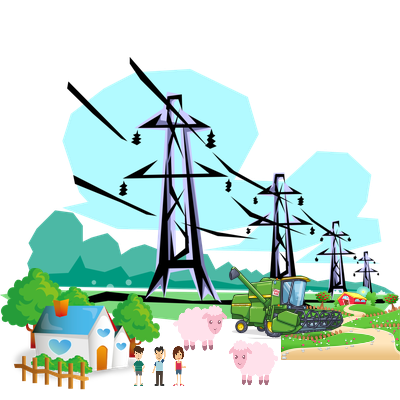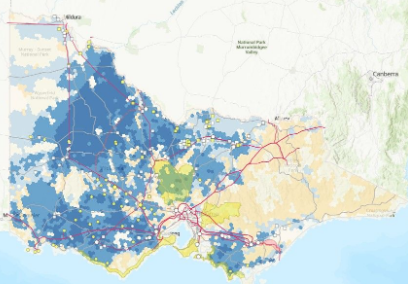
This page is an abbreviated version of a longer document (pdf file) about engagement that you can download.
Failure
Firstly, the evidence of large and recurring protests both in-person and online are enough to say that the current engagement process is broken, or in fact has failed. Also, witness the fact that most public meetings and even AEMO’s community consultation groups have security personnel or even police present.
For more evidence, take a look at the map of opposition to VNIWest, produced by the Regional Victoria Power Alliance.
One of the problems is that the vast majority of people and companies involved in the energy transition are not involved in community engagement, they just assume it’s happening or even that it has already happened.
It’s not clear where the responsibility for community engagement lies because the energy transition is a mash up of federal and state government bodies and a big contingent of industry.
Leadership is scarce.
There are many people, especially (almost exclusively) online who make statements about how successful and extensive community consultation is occurring. Very few of these people are actually engaged in the process and their views must be heavily discounted. This includes everyone from ministers of government to AEMO and industry executives. It’s a matter of fact that these people are far removed from the engagement process, yet they make many unsubstantiated statements about the process.
As a member of the AEMO Community Reference Group for VNI West it was enlightening when it was admitted by the senior AEMO representative that the minutes are not passed up to anyone at AEMO, or anyone else, ever.
The Bubble
The speed and the way that governments have engaged with the energy industry has meant that most of the people involved in the energy transition are inside a giant bubble.
The scale of this bubble completely dwarfs the community groups affected by the renewable energy projects. This gives the impression that everything is ok because voices to the contrary are minimal.
Just look at the sheer number of conferences and briefings that are reported on professional social media such as LinkedIn. Then look at the comments. The furious self-congratulating is astounding. The bubble is self-sustaining.
Discussion is all about just how great the transition is, how many opportunities are coming up and so on, which is fine, but there is practically no recognition of the impact on communities. The assumptions about the availability of so-called renewable energy zones have created a mindset that completely ignores any negative impacts. This mindset has well and truly permeated throughout the bubble.
The recent release of the Victorian government Renewable Energy Zones is another good example of the bubble.
A LinkedIn post celebrating the mapping of the zones declared, “The map includes all planned and operational solar, wind, and battery projects, along with transmission infrastructure. It features renewable study areas - potential sites for future clean energy generation and transmission”.

Well, actually this is a map of highly productive farmland, of people’s homes, their backyards and chicken pens. The bubble people just take it as a given that the land is available.
Presentation of facts
One of the truly frustrating aspects of the energy transition is the lack of transparency. It is no doubt frustrating for the bubble people to have to repetitively explain themselves too, but that’s what it takes, some effort.
Government and industry have done a terrible job of explaining.
As a part of being on a community reference group, I talk to many local people in order to convey their concerns. The most common questions are the big ones.
- Why do we need these transmission lines?
- How many more lines are required?
- Why can’t the lines be underground?
- How much land will be needed for wind and solar?
- Will it affect insurance costs?
- What happens if agricultural machinery damages a tower or causes a fire that damages a solar/wind facility?
- What are the dangers and rules around firefighting near renewable energy facilities?
- What is the compensation package?
- Why is there no compensation for neighbours to energy infrastructure?
- Why are there no comprehensive policies and regulation for wind and solar development?
Please download the longer document (pdf file) to see more comments related to these questions.
While there has been much, much discussion and decisions made about these questions within the bubble, very little has been done to provide information to local communities and the broader public. In the community reference group for VNI West, with over twelve months of meeting, not a single question put forward has been answered. Some have been rejected, but none answered. If AEMO can’t even put in the effort to convince people who have voluntarily come forward to hear more, then the only conclusion is that there is no serious intention to inform.
While the communities are crying out for real factual data it seems more and more that the whole basis of what is proposed is still in question. No one seems to know whether any particular renewable energy facility is a good idea or not.
Policy making
Policy making is failing at the very highest level. Current policies, where they exist, are full of unconscionable outcomes that impact local communities.
Renewable resources such as sun and wind are not owned by anyone. And yet some landholders are receiving millions of dollars each year for wind turbines after the wind blows off a neighbours property and yet the neighbour receives nothing. This divisive policy (or lack of any policy) is destroying communities, not assisting them. What policy allows this outcome?
With all the might of multiple governments we still don’t have policies that link the broader energy transition to real benefits for local communities?
Platitudes
A typical response from the head of VicGrid - “VicGrid is committed to listening to the views of individuals and the broader community and we are keen to ensure we can factor your thoughts into how the project develops”. This is absolutely typical of the platitudes handed out at every community consultation group. It doesn’t matter whether its Solar, Wind, WRL, HumeLink or VNIWest the community groups get the same brush off.
Transition to a new normal
In the future it may be that farmland will be multipurpose and some forms of agriculture can coexist with renewable energy facilities. Perhaps younger generations will welcome any additional income to get started in a difficult industry.
But that’s in the future, any transition plan needs to get there first.
So why is community engagement failing for the energy transition – well nobody likes to be taken for granted.